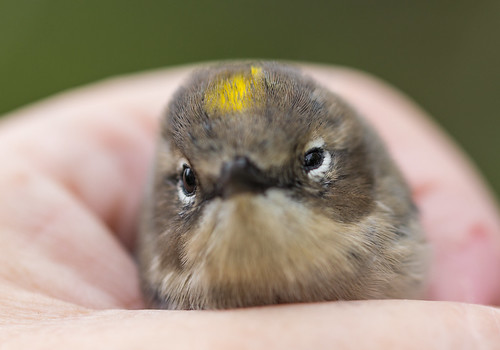 |
Some conservationists decry this impulse because to protect
species and biodiversity, we really must focus on populations rather than
individuals. But caring about individuals does not negate caring about the
larger picture. On the contrary, some of the world’s finest conservationists were
originally sparked by a magical face-to-face encounter with one individual
animal. I’d argue that in order to be fully human—the best of all we can be—our hearts and our minds must
both be fully engaged.
Yet some conservationists and biologists ridicule
wildlife rehab centers because of their focus on individual creatures, and a
few, like Robert Zink of the University of Minnesota and Paul Kerlinger of
Curry & Kerlinger, “Consultants to the Wind Power Industry,” even pooh-pooh
efforts to stop construction of potentially massive bird killers like the proposed Vikings
Stadium or the AT&T lighted, guyed tower on the edge of the Boundary Waters.
Individual bird lives mean absolutely nothing to them—they both have claimed
that even egregious deathtraps causing the deaths of hundreds or thousands of
birds each year won’t affect populations. By rejecting, or perhaps not even
sensing, the impulses of their own human hearts, these scientists may believe
they’re espousing Spock-like wisdom, but their cold and unfeeling message makes
the human beings hearing them turn away from both them and such a coldly
scientific approach to other issues as well, adding fuel to the anti-science
sentiments that are so polarizing our society. This is ironic, because their claims are not even supported by science.
I’m not normally one who sees the world through the prism of
the original Star Trek series, one of the rare TV shows with nary a bird in the
soundtrack, much less mentioned in the dialog. Space may be the final frontier,
but as Robert Frost almost said, “Earth’s the right place for birds: I don’t
know where else they’re likely to live.” Even so, Star Trek can at least give
us a model for how in wildlife and conservation issues, attention must be paid
on both the Spock-like scientific front and the McCoy-like heart front. It’s
Captain Kirk who embodies both.
The human heart is not supposed to take precedence over our
brain—a world of all McCoys would be at least as dangerous as, and far more
backwards than, one of all Spocks. For example, people who look at individual
feral cats and can’t bear the thought of euthanizing a single one even as they realize
they can’t find them all homes as indoor cats are the ones who started the
fundamentally flawed Trap-Neuter-Release projects. Now that many of these
programs have been in existence for several years, it’s increasingly obvious
that they haven’t helped—the number of feral cats continues to climb even within
these colonies, and because people provide supplemental food and veterinary
care that extends individual feral cat lives far beyond what natural predators enjoy,
these subsidized killers take out many times the number of prey animals in their
territories than natural predators possibly could. The human heart focusing
entirely on individuals willfully closes its eyes to all this collateral damage. Finding a truly
wise solution to the feral cat situation, and all kinds of other important
conservation issues, requires integrating mind and heart. The Spocks and McCoys
among us have valuable input, but it’s the Captain Kirks among us who must synthesize
it to find the wisest solution. Where we’ll find them, I just don’t know.
But science is a particular and painstaking process of finding
answers based on making hypotheses and experimenting, and the more complex the
questions, the more difficult and time consuming it can be to tease out clear
answers. Meanwhile, it can be disturbingly easy to twist scientific data so
that it appears to answer a question that it does not. As a
society confronted with immediate problems, we often believe a scientist citing numbers to make a claim without considering what those numbers actually mean. And we often need to make decisions
before all the data are gathered, much less synthesized into irrefutable
scientific fact. If this were a Star Trek scenario, what’s a Kirk to do while
Spock is still mulling, a Romulan is making false claims, and McCoy is yelling his head off?
The Honorable Philip D. Bush had to play the Kirk role in
the Boundary Waters case. On every issue, he found on behalf of the
plaintiffs—the Friends of the Boundary Waters—who were claiming that the
proposed guyed, lighted tower on the very edge of the Boundary Waters Wilderness
Area would harm the wilderness values. The Minnesota Environmental Rights Act defines
these values carefully, and requires that if a proposed project does in fact cause
any demonstrable harm to the state’s natural resources, and if a less harmful
alternative can be found, regardless of cost, it should be chosen.
Paul
Kerlinger, presenting himself as the objective, scientific Spock, testified under oath that at most, 48 birds a year would be killed at
the tower—where he pulled out that purely speculative, unscientific, and most unSpock-like number was
anybody’s guess, but AT&T was clear that the Ph.D. after Kerlinger’s name gave
him far more credibility than the Mrs. in front of mine did. Judge Bush wrote in his findings: “He is a private consultant and testifies exclusively for the
wind and cell-tower industries. The Court does not find Kerlinger’s opinions
about very low probable bird mortality at the Proposed Tower to be credible.”
AT&T could have built a single 199-foot tower on the same site rather than their 450-foot tower, which they did not argue would provide significantly more coverage. Alternatively, they could have built two 99-foot towers spread apart, which would definitely have provided significantly more coverage for little more cost. Judge Bush’s 58-page decision included 239
findings of fact and 69 conclusions of law in his summary finding for the
Friends of the Boundary Waters. AT&T appealed, and the Appeals Court, in bizarrely
non-analytical, rather Klingon-like fashion, from the gut rather than the heart or mind, threw out
Bush’s carefully weighed findings, saying simply that the Boundary Waters was
not “pristine wilderness” anyway, and that public safety was critical. The
Minnesota Supreme Court refused to hear the case.
In the current Vikings stadium issue, Robert Zink, like Paul
Kerlinger, agrees that the proposed windows will kill birds. He even agrees
that the number may be large. His argument is that it doesn’t matter, because
one building, even with 180,000 square feet of glass on a major migration
flyway, won’t hurt bird populations any more than a litany of other things
hurting birds. He said that people keeping their cats indoors would protect
more birds, but that was hardly based on scientific analysis: individual cats kill fewer birds per year than many individual large
glass structures do, and overall cats and collisions with glass cause bird
mortality of the exact same order of magnitude. The real Spock would never make such unwarranted claims. Kerlinger and Zink both trust that judges
and public opinion will be swayed not by scientific analysis of their statements
but by their Ph.D's, even though neither has a background in population biology.
Both Kerlinger's and Zink’s main contention is fundamentally flawed,
scientifically. They say that lighted, guyed towers or buildings with large
amounts of glass don’t hurt populations, when what the data actually say is
that we don’t yet know the precise effects of any individual human-caused bird mortality on populations, even as we can clearly see that some populations are declining precipitously. They
carefully skirt the question most people think they’re answering: when a
species such as the Golden-winged Warbler—one Zink himself calls a
“super-collider” because it’s killed in collisions in numbers far above average—is
already dangerously declining, how well can that species absorb additional mortality?
When there are so many unknowns, how do we make decisions in these cases, and who is to judge? And even if Captain Kirk were to show up, how would we deal with his overacting and insufferable arrogance? My favorite single line in any Star Trek movie or episode comes from the end of Star Trek IV, when the pretty whale biologist kisses off Kirk with a satisfyingly final “See ya ‘round the galaxy.” Nobody’s perfect—that is the nature of human beings, even Captain Kirk. And there are no perfect answers to the important conservation issues facing our world. But as human beings, we must use the tools we have to solve them. Brains and heart. Without either, we lose our way.
When there are so many unknowns, how do we make decisions in these cases, and who is to judge? And even if Captain Kirk were to show up, how would we deal with his overacting and insufferable arrogance? My favorite single line in any Star Trek movie or episode comes from the end of Star Trek IV, when the pretty whale biologist kisses off Kirk with a satisfyingly final “See ya ‘round the galaxy.” Nobody’s perfect—that is the nature of human beings, even Captain Kirk. And there are no perfect answers to the important conservation issues facing our world. But as human beings, we must use the tools we have to solve them. Brains and heart. Without either, we lose our way.




